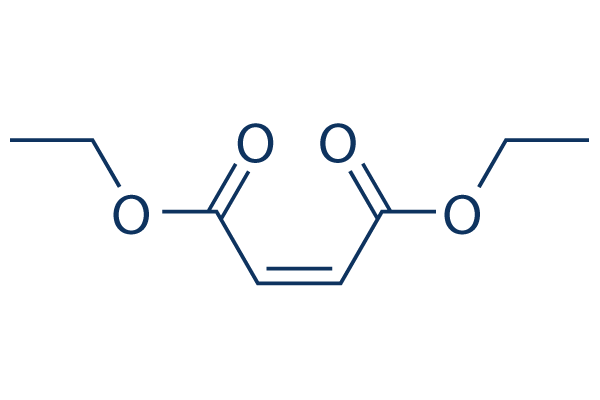All AbMole products are for research use only, cannot be used for human consumption.

In vitro: DEM induces upregulation of GSH(L-c-glutamyl-L-cysteinyl-glycine) metabolism, and the downregulation of pathways of cancer, chemokine signaling, cytokine-cytokine receptor, and focal adhesion in transformed cells. DEM appears to modify microenvironment of transformed cells thereby restraining tumor cell growth. DEM is cytotoxic to the transformed cells in a concentration dependent manner. DEM at 0.25 mM decreases cell viability to 75%. The co-exposure of cells to DEM+GSHe inhibits DEM induced cytotoxicity. DEM exposure increases the ROS generation by multiple orders of magnitude in transformed cells. This is evident from the dose and time dependent increase in fluorescence intensity of CMH2DCFDA. Moreover, DEM activates MAPK pathway and DEM induced activation of ERK is found to be due to phosphorylation at Thr 202/204.
In vivo: Sperm motility and epididymal sperm count are significantly reduced in the DEM treated animals. Fertility status is also affected by DEM exposure as is evident from the percent fertility and the litter size. consequences of the oxidative stress produced by the DEM induces glutathione depletion, on the reproductive ability of male mice and modulation of the various components of the antioxidant defense system at the transcriptional level.

J Agric Food Chem. 2023 Dec 13;71(49):19465-19474.
CYP4CL2 Confers Metabolic Resistance to Pyridaben in the Citrus Pest Mite Panonychus citri
Diethylmaleate purchased from AbMole
| Cell Experiment | |
|---|---|
| Cell lines | Transformed cells (tC3H10T1/2 and tBALB/c) |
| Preparation method | A stock solution of DEM is prepared in 100% DMSO and diluted in DMEM to achieve the desired concentration with less than 0.1% DMSO in the culture wells. Briefly, cells are seeded (1 ×104 cells/well) in 96-well plates and allowed to adhere overnight. Subsequently, these cells are exposed to DEM at various test concentrations (0.05-1 mM) or co-exposed to equimolar (0.25 mM) DEM+GSHe for 24 h. Cell viability is determined by recording the OD at 570 nm in an Elisa microplate reader. |
| Concentrations | Various test concentrations (0.05-1 mM) |
| Incubation time | 24 h |
| Animal Experiment | |
|---|---|
| Animal models | Sprague-Dawley rats |
| Formulation | corn oil |
| Dosages | A range of doses up to a maximum of 6mmol/kg |
| Administration | i.p. |
| Molecular Weight | 172.18 |
| Formula | C8H12O4 |
| CAS Number | 141-05-9 |
| Form | Liquid |
| Solubility (25°C) | DMSO 90 mg/mL Soluble in Ethanol |
| Storage |
Powder -20°C 3 years ; 4°C 2 years In solvent -80°C 6 months ; -20°C 1 month |
| Related NF-κB Products |
|---|
| Safranal
Safranal is an orally active component of Saffron (Crocus sativus). Safranal has neuroprotective and anti-inflammatory effects and it can be used for the resaerch of Parkinson’s disease. |
| DCZ5418
DCZ5418 is an inhibitor of TRIP13. |
| Ro 106-9920
Ro 106-9920 is a potent inhibitor of NF-kappaB. |
| MRS2693 trisodium
MRS2693 trisodium is a selective P2Y6 agonist with an EC50 value of 0.015 μM. |
| PTD-p65-P1 Peptide TFA
PTD-p65-P1 Peptide TFA is a potent, selective nuclear transcription factor NF-κB inhibitor and derives from the p65 subunit of NF-κB amino acid residues 271-282, which selectively inhibits NF-κB activation induced by various inflammatory stimulation, down-regulate NF-κB-mediated gene expression and up-regulate apoptosis. |
All AbMole products are for research use only, cannot be used for human consumption or veterinary use. We do not provide products or services to individuals. Please comply with the intended use and do not use AbMole products for any other purpose.


Products are for research use only. Not for human use. We do not sell to patients.
© Copyright 2010-2024 AbMole BioScience. All Rights Reserved.
